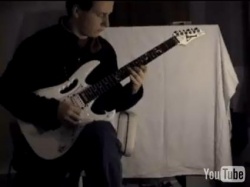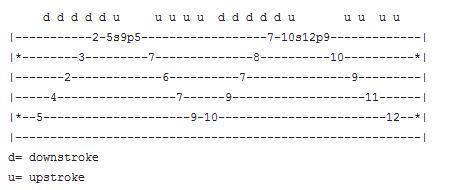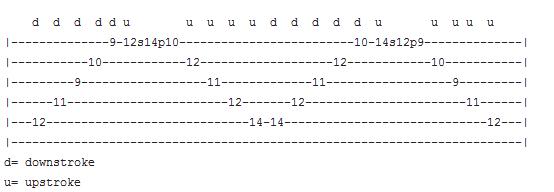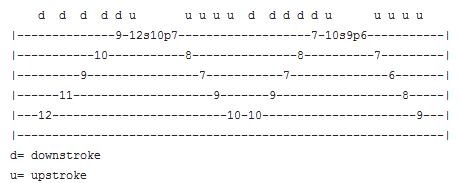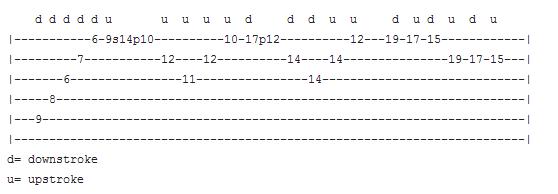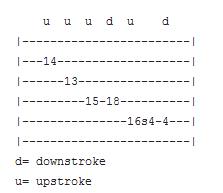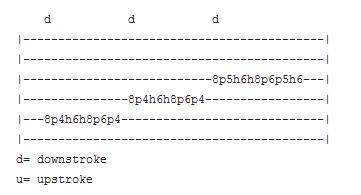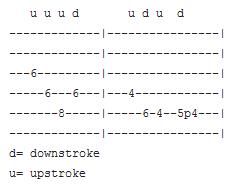Tolek - Sweeping & Legato SI Lesson
Contents |
Introduction
Hey folks,
my name is Anatol Maximilian Konior. That´s a bit long, so just shorten it and call me Tolek.
I am 17 years old and I live in Luxembourg. I`ve been playing classical guitar for 7 years and electric guitar for 3 years now. I mainly spend my days with practising, I still can´t stop.
I hope you will like my first lesson.
Structure
About the Lesson
The Lesson
Harmonic Analysis of this Lesson
Last Words
About the Lesson
Sweeping is a very difficult technique and a lot of lessons show the use of it in an extremely fast way. Personally, I became a bit frustrated when seeing not only the instructors but also the great guys of the guitar world sweeping like crazy. That´s why I decided to do a pretty slow lesson on sweeping. When I finsished a long lick, I started to play some legato and I asked myself: 'Why not some legato in that lesson?' So, the second part consists of long legato runs in order to develop your left hand strength. In my opinion, legato is a good manner to play really cool stuff plus it makes your left hand feel really comfortable on the fretboard.
I suppose that you know the sweeping basics. If not, check out this fantastic lesson.
Tempo is 75 bpm. This exercice starts in D Major and ends in C# Major.
Well, let´s start.
The Lesson
These are basic 5-string-sweeps over D Major, F# minor, G Major and A Major chords which gives us a nice intro and defines the D Major scale. Talking about rhythm, the notes are all 16th-triplets.
Here we repeat the same shape as in the first bar. We start with an A Major chord (V degree of D Major scale) which is followed by a B minor chord (VI degree of D Major scale). This succession of degrees is called Deceptive Cadence because it gives a musical surprise. The listener supposes that the V degree goes back to the I, but in that case, a completely new dimension/atmosphere is created.
All notes are 16-triplets, again.
This bar starts with an A Major triad, too. On the 2nd beat, we have a G Major chord followed by a F# Major chord on the 4th beat. Guess what rhythm we have. ![]()
We continue with the F# Major Arpeggio, this time the melody goes up. After a slide to the 14th fret, we sweep only over 3 strings, first over the B minor chord and then over the A Major chord. We end this bar with a descending lick which goes stepwise from B to D as we want to reach C#. Rhythmically we stay the same.
(SAME VIDEO AS FOR THE PREVIOUS EXAMPLE BECAUSE I MESSED UP A BIT... I FORGOT TO DO TWO DIFFERENT VIDEOS, SORRY)
Hurray! Another rhythms are waiting for us. The measure consists of 4 16th notes, one 8th note with a dot, a 16th note and a half note. This bar is used to modulate in a proper way (by using a simple C# Major triad) into C# Major which is a half step lower than D Major.
A completely new atmosphere is created in this 2nd part due to the modulation. Also, we don´t sweep anymore - the technique used here is the well-known legato. Pick the first note on every string to accentuate the on-the-beat-notes. There are 16th-triplets again. This scale is used.
This lick is very simple. We use a pattern over the whole C# Major scale on one single string. Pay attention to the correct switching of position. Rhythm is again the same: 16th-triplets except from the last note which a quarter note. This scale is used.
Nearly the same lick as in the previous one is used here, we just return to low C#. Again pay attention to the correct switching of position. Same rhythm: 16th-triplets and a last quarter note. This scale is used.
I think that this very popular song ending would be perfect here. This is my little present to you all for Christmas ![]() You can use economy picking or just alternate picking. I prefer the first. You wonder why I decided to end very anormally. I thought of reminding the listener of the previous part, so I played a D grace note before the C#. This time the rhythm is a bit complexer: 3 quarter triplets, 1 quarter, 1 16th followed by a 8th with a dot, a half and finally a quarter note that is linked with a whole note in the next bar.
You can use economy picking or just alternate picking. I prefer the first. You wonder why I decided to end very anormally. I thought of reminding the listener of the previous part, so I played a D grace note before the C#. This time the rhythm is a bit complexer: 3 quarter triplets, 1 quarter, 1 16th followed by a 8th with a dot, a half and finally a quarter note that is linked with a whole note in the next bar.
Analysis of this Lesson
This lesson is divided into two big parts:
1st Part: Sweeping, D Major
2nd Part: Legato, C# Major
In the first part, we concentrate on sweep picking. I tried to use only one shape in order to get that one down. One exception is the A Major 3-strings-sweep. The first few bars are in D Major. On the last beat of measure 4, we borrow the leading note of the parallel tonality which is a A#, the augmented VII degree of B minor. Measure 6 modulates into C# Major and leads us to the second part.
The second part builds up our legato skills. Pick as little as possible, if not, your left hand will work less and develop less. Harmonically speaking, we modulate a 2nd min down to C#. There are no out-notes except from the last grace note which reminds of the previous key.
Last Words
I hope you enjoyed my first lesson on GMC. I worked for the last two days on it and it was pretty much work. I learnt a lot about recording, 'Exploring Guitar' and Sweeping&Legato of course. ![]()
Some hints for practising: make sure that you understood the basics of Sweep Picking and Legato; practise with a metronome; record yourself so that you can see your progress. If you want, you can show me a video of your take and I´ll comment it.
Thank you for watching my videos and reading the descriptions. If you are unsure about anything, feel free to ask me. I am keen to help you. I can´t sleep well if I know that you have troubles, so please let me really know about your progress with this lesson.
Attachments
Backing track: Sweep_Picking___Legato_Lesson.mid ( 14bytes )
GuitarProFile: Sweep_Picking___Legato_Lesson.gp5 ( 7.41K )



